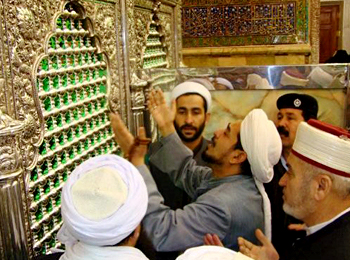 Wahhabi Sect is one of the most conservative sects of Islam. Even though the Wahhabi Movement was a modern one, it is quite traditional in the values that it preaches. The Wahhabi Movement, which led to the formation of the Wahhabi Sect, was launched by Muhammad Ibn Abd Al Wahhab. In the middle of the eighteenth century Muhammad Ibn Abd Al Wahhab had read and was moved by his study of the works of lbn Taimiya. He went on to become a follower of Ibn Hanbal and vehemently protested against the innovations which had invaded Islam. The movement swept through Arabia and is now the religion of the entire peninsula except the south. Every revolution has claimed to be a return to the Holy Quran and this one is no exception. However, this revolution was different in that it literally meant what it preached. The followers of this sect call themselves Unitarians or Muslims.
Wahhabi Sect is one of the most conservative sects of Islam. Even though the Wahhabi Movement was a modern one, it is quite traditional in the values that it preaches. The Wahhabi Movement, which led to the formation of the Wahhabi Sect, was launched by Muhammad Ibn Abd Al Wahhab. In the middle of the eighteenth century Muhammad Ibn Abd Al Wahhab had read and was moved by his study of the works of lbn Taimiya. He went on to become a follower of Ibn Hanbal and vehemently protested against the innovations which had invaded Islam. The movement swept through Arabia and is now the religion of the entire peninsula except the south. Every revolution has claimed to be a return to the Holy Quran and this one is no exception. However, this revolution was different in that it literally meant what it preached. The followers of this sect call themselves Unitarians or Muslims.
Beliefs of the Wahhabi Sect
 The Wahhabis believe that there is no intermediary between God and man and therefore they detest the worship of saints and condemn prayers and sacrifices to them as idolatry. When the protestors in the Wahhabi movement captured Mecca in 1806 they destroyed the tombs which others venerated. Much like the Kharijis, the Wahhabis may be called the Puritans of Islam. They believe that when possible, all prayers should be said in the mosque which is very plain. Simplicity in dress is essential, gold ornaments are forbidden, and there is no music. Worship according to the Wahhabi sect is based on the conventional ways of worship including Dua, five times daily prayer, fasting, Istiadha, Istiana and Istigatha. Blind acceptance of the practices that have been taking place within families or tribes is strictly prohibited as is blind adherence to the teachings of scholars.
The Wahhabis believe that there is no intermediary between God and man and therefore they detest the worship of saints and condemn prayers and sacrifices to them as idolatry. When the protestors in the Wahhabi movement captured Mecca in 1806 they destroyed the tombs which others venerated. Much like the Kharijis, the Wahhabis may be called the Puritans of Islam. They believe that when possible, all prayers should be said in the mosque which is very plain. Simplicity in dress is essential, gold ornaments are forbidden, and there is no music. Worship according to the Wahhabi sect is based on the conventional ways of worship including Dua, five times daily prayer, fasting, Istiadha, Istiana and Istigatha. Blind acceptance of the practices that have been taking place within families or tribes is strictly prohibited as is blind adherence to the teachings of scholars.
The entire doctrine of Wahhabi is based on the concept of the unity and uniqueness of God, known as Tawhid. God is the only object of worship and whosoever worships anything else deserves death. Most men are not monotheists because they try to win God`s favour by visiting the graves of saints. They are like the idolaters of Mecca spoken of in the Holy Quran. It is polytheism to mention the name of a prophet, saint or angel in prayer, to ask the intercession of anyone with God or to make vows to any but Him. It is unbelief to accept as knowledge anything that is not confirmed by the Quran, Sunna or strict reasoning. The Quran and the Hadith are taken as the only authoritative texts. The Wahhabis hold that it is unbelief and heresy to deny God`s control of all acts. It is unbelief to employ adopt an allegorical interpretation of the Quran.
Religious Practice of Wahhabi Sect
Wahhabi teaching differs from that of Ibn Hanbal in that it makes attendance at prayer in public a duty. The shaving of the beard and the use of abusive language are punished by the judge at his discretion. Religious alms are paid on the profits of trade and not only on visible capital. The utterance of the confession does not make a man a Muslim so that an animal killed by such a man is not lawful food for a Muslim. The Wahabbis do not believe in the concept of eating houses. This is because they hold that an honourable man cannot go to a place where he pays for what he eats and others see him. When the looker-on is hungry and has no money to buy, the eater is ashamed and the looker-on filled with forbidden desires. Houses and clothes are plain, laughter and music are forbidden and singing is effeminate. Chess is forbidden because it might make the players forget the hour of prayer. As to moral value there are not five classes of acts but three only, the commanded, the forbidden, and the indifferent.
Thus discussed above is a brief look into the emergence and dogma of the Wahhabi sect in Islam.




















